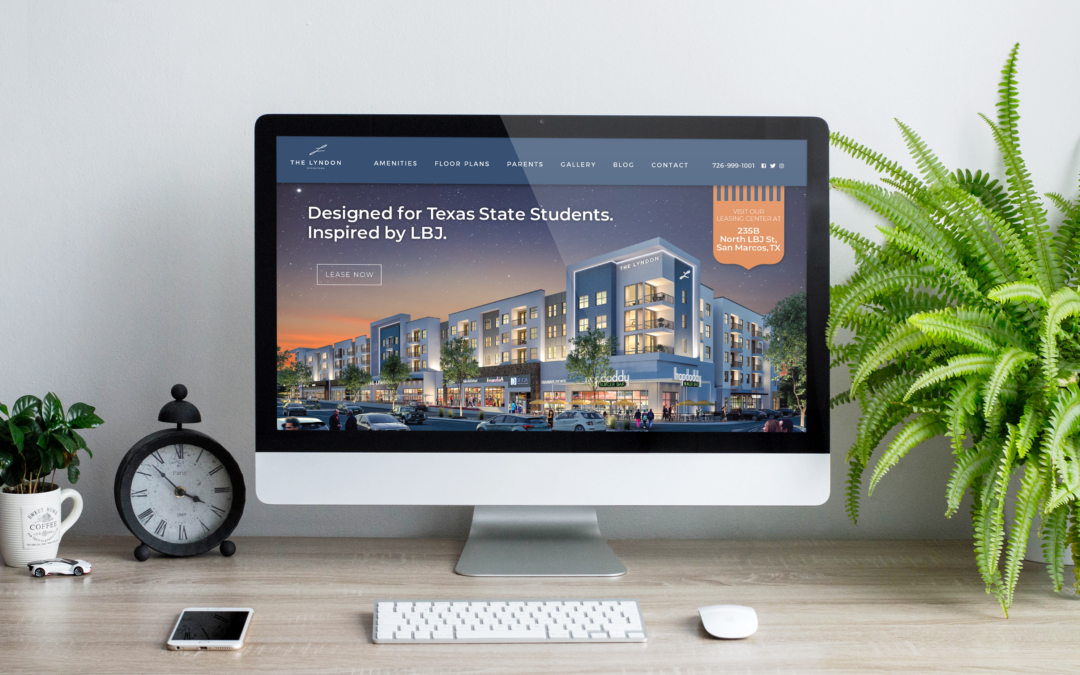
by threshold | May 7, 2020 | Digital Marketing, Marketing
So you’re taking over a property and you’re ready to hit the ground running on all your marketing to-dos. Congratulations! We’d love to help you with next steps as you grow your portfolio. Property takeovers come with their own set of marketing challenges, but we’ve been around the block a time or two; here’s what you need to know to set your newest acquisition up for success!
Get a Handle on Reputation Management
One of the first things you’ll want to do is claim all the reputation management accounts for your acquired property, transferring the accounts over from the old management. Google My Business should be top of your list; request management of the page and then apply for ownership of the profile using these instructions from Google. You’ll also want to transfer ownership for management accounts on Yelp, Apartments.com, ApartmentRatings.com, and Apartment Guide, or set up management accounts on these sites if they don’t already exist.
Once you’ve claimed your property’s profile on Google My Business, you’ll want to ensure all the info is up-to-date, including contact information and the website URL.
When a property has poor ratings and reviews on reputation management sites like those listed above, you may want to consider a rebrand. A new identity including a new name and logo may help you shake off the effects of previous management mistakes or public relations snafus. If you’re looking for a marketing partner with experience in rebranding, we’re here to help!
Make the Website Work for You
Whether you negotiated for the website and domain or you need to create a new website, there are a few items you’ll need to check off in order to ensure your property’s website works for you.
Firstly, if you need to create a new website or revamp the old one, we recommend partnering with a marketing agency with experience building real estate websites that drive conversions and enhance organic traffic. We can certainly help with that, no matter what your budget looks like (let’s talk if you’re interested). In the meantime, you may want to build a single landing page that can go live while you continue work on your full website (and what do you know, we can help with that too).
If you’re using an existing website, you’ll want to request a domain transfer. The domain provider should have instructions on how to do this. GoDaddy.com is a common one; their instructions can be found here.
Whether you need a new website or not, your next steps are to set up Google Analytics and install new Google Tag Manager code on the site. Have ownership of Google Analytics transferred to you (including all GA that may be on the website; select one to move forward with to act as your primary GA account). If an ownership transfer is not possible, create a new Google Analytics account and add it to the website or have your digital agency create a Google Analytics account for you.
Claim Social Accounts
Social media accounts are essential to strong digital marketing, so it’s crucial that you also transfer ownership of these accounts from previous management.
When it comes to Facebook, you’ll want to first have the prior management add you as an admin of the page. Then you’ll need to go through the more demanding process of contacting Facebook to gain ownership of the page. Then remove any old admins that should no longer have the ability to manage the page.
For Instagram, you’ll simply need to have the previous management update the email address associated with the account, then share their existing login credentials with you so you can access the account and update the login info.
Update Existing Digital Ads (or Create New Ones)
Before launching new digital campaigns, you’ll want to find out if previous management had any running already that you’d like to continue. This may require some digging in Google Ads (ask for the ownership to be transferred by previous management if you haven’t already, instructions here), Facebook Ads Manager, and other ad management accounts. If display ads are running that need to be updated (for example with a new name, logo, or special), have your in-house marketing or agency partner update those for you so your campaigns can continue seamlessly.
Establish Great Email Marketing
As you get all the digital technicalities squared away, don’t neglect the human side of your property takeover. Existing residents want to know they can trust their new management and setting up great email marketing can be a great way to do that. Design a professional, branded email template (or two) you can use from your very first “Nice to meet you” message to every resident event announcement, community update, and holiday greeting to come. You’ll also want professional branded templates for your transactional emails and prospect responses. We just happen to have done plenty of email designs for real estate brands, so don’t hesitate to reach out if you’re looking for help.
That’s it for our property takeover tips! From reputation management to Google Analytics setup to designing new display ads and email templates, there’s a lot to check off your list to ensure a seamless transition. If you’re looking for more advice or help getting started, we’re happy to put the full force of our digital and creative teams at your back! Reach out to our team to learn more about our full-service agency.

by threshold | Mar 25, 2020 | Digital Marketing
All eyes are on COVID-19 right now as our communities work to address the ramifications of a pandemic on people, businesses, and our world. The real estate industry is no exception; in addition to questions of investment, development, and the management of current residents and employees, marketers are working hard to understand how they can adapt during this time. They’re looking for apartment marketing ideas for COVID-19 that can withstand the instability of a pandemic and support financial health while properties maintain essential operations.
And that’s just what we’ll be discussing here. This blog will not, of course, replace your legal counsel or supersede the guidelines of government officials—we urge you to seek out the counsel of those professionals first and foremost. That said, this post will arm you with marketing best practices during this pandemic to help support your community and investments during this challenging time.
Establish Teleconferencing for On-Site Staff
You have likely begun making this shift already, but it’s essential that you provide clear and consistent guidelines for your on-site and leasing staff when it comes to operating remotely and maintaining essential operations. Ensure your staff members have the equipment and software they need to reliably conduct video calls with coworkers, residents, and prospects.
Offer Virtual Tours
One of the chief challenges of real estate marketing in the time of COVID-19 is that in-person tours are no longer viable due to social distancing practices. Offering an alternative can help get prospects the information they need to sign a lease with confidence.
If you don’t already have a virtual tour option, now is a great time to create one. One option is to offer on-call virtual tours where a member of the leasing staff walks the prospect through the show unit while on a teleconferencing call with them. Another virtual tour option is to simply record such a walkthrough and provide the video on your website, via email, and even on social media. This second option ensures additional protection for staff because they will not have to leave their homes to conduct multiple tours through a show unit that has been visited by many people.
Make Full Use of Existing Software
Software solutions exist for many of your daily operations needs—now is a good time to lean on them. Your CRM software is a great place to take excellent notes about leads coming in to ensure continuity between their interactions with various staff members, even when your team is working remote. Additionally, teleconferencing software options are abundant and many are free to use. Google Hangouts has even extended its functionality recently and other platforms are making similar adjustments.
Enhance Your Online Presence
It’s never been more important to have all the relevant info a prospect needs available online. Ensure a prospect can find your property and determine whether it’s right for them all within the convenient confines of their browser window.
Property Website
Your property website should have solid SEO, great UX, and clear Calls to Action so that it can drive conversions. Consider adding a “Virtual Tour” or “Contact Us” CTA button above the fold on your home page to encourage further action from site visitors.
If you don’t already feature 3-D floor plans, unit availability, and pricing info on your website, now is a great time to add this functionality. This way a prospect has the tools they need to determine that your property is right for them without the added difficulty of contacting staff and waiting for a response, which can cause prospects to pass you up for a property offering a more convenient buyer experience.
For current residents, ensure your website also provides a clear and working link to your resident portal where they can pay rent online and access any statements you have or will release about COVID-19.
For prospects, ensure there is a clear link for online applications that allows them to submit and sign an application digitally.
Google My Business
Although Google My Business has shut off reviews for the time being, this is still a helpful resource you can use to provide visibility to your property. Make sure to provide complete contact info on your Google My Business page so prospects can email or call easily if they want to know more. You can also feature property photos on your GMB page and feature available units in GMB posts so that a prospect knows you have what they’re looking for even before they choose whether or not to click the link to your website.
Review Existing Creative & Digital Assets
Across all your messaging, whether it’s website copy, a display ad, or paid search copy, ensure your messaging is consistent with current circumstances and availability. Do you have a CTA that reads “stop by for a tour!” You might need to update this to “take a virtual tour.” Do you have an ad that focuses on a community amenity that’s currently closed to residents? Consider replacing it with one that focuses on apartment amenities.
It may also be a good time to enhance your paid search ads with more robust extensions so that you provide your audience with more reasons to convert. Consider showing floor plan prices, call extensions, dynamic call-outs, and other extensions on your paid search ads through Google Ads.
Focus on Email Communications
Inspiring confidence in current residents and prospects is key right now, and email communications are the best way to reach your audience while offering a personal and professional touch. Be clear and communicative with residents and leads. Make sure they know what they need to do and how they can reach on-site staff.
Everyone has questions right now, and the ability to communicate is key. Take some time to ensure you have quality contact info for all of your residents so that you can make timely announcements and communicate reliably with everyone in your community.
Email marketing allows you to take a personalized approach to lead nurturing—prospects need to know leasing staff are accessible by email, phone, or video call to get the help they would normally get in person. It can also help them lease with confidence at a time when they can’t gain the reassurance of touring the entire community in person or speaking with a staff member on site.
We hope these tips help you adjust your real estate marketing plan in the face of COVID-19. For more insight into how you can respond to this pandemic, we invite you to check out this list of resources compiled by NAA. And don’t forget, Threshold’s digital, creative, and customer service teams are always here to help.
If you’re interested in expert assistance, reach out to a Threshold team member today.

by threshold | Mar 10, 2020 | Digital Marketing
Imagine you’re searching for an apartment. You’re served an ad with stunning imagery, a compelling headline, and a button inviting you to “Find Your Floor Plan.” With your interest piqued, you click on the ad, only to arrive at a webpage that baffles you. As you wait for it to load, you find messaging not about floor plans but about an amenity you don’t care about. A quick scroll doesn’t help, revealing only more slowly loading images and blocks of irrelevant text. You close the page, frustrated, and return to what you were doing.
As real estate marketers, we rejoice when an ad, email, or social post has a high click-through-rate. It indicates that we’re persuading our audience to take the next step on their buyer journey. But click-throughs are only half the challenge. It’s just as important that the web page a user lands on leaves a good impression and inspires further action. It’s surprisingly easy to build a landing page that utterly fails at this job.
So how do you build a good landing page? That is to say, what’s the recipe for a landing page that actually turns clicks into conversions? How do you provide an excellent user experience that inspires further action and results in more signed leases?
These seven tips are essential to building conversion-optimized landing pages that get the results you need.
Know The Goal
First thing’s first: what is your landing page actually supposed to do? Yes, you want it to drive conversions and contribute to increased lease rates, but what role does this landing page play in that larger goal? Be as specific as possible—your landing page can’t do everything, and it’s not meant to. The more focused a landing page is, the more likely it is to drive the conversions you’re seeking.
So, do you want to capture email addresses? Get people to schedule tours? Drive applications for specific floor plans? Whatever your goal, it should be focused and action-oriented. Not only does that translate to meaningful impact on your bottom line, but users appreciate knowing right away how they’re meant to interact with a page.
Use Consistent Messaging & Design
When you click on a button that says “Find Your Floor Plan,” you expect to be taken to a page that features floor plans. When you click on an ad that promises “Downtown Lofts With Active Living Amenities” you probably expect to find information about amenities. When a user is inspired to click, it’s because they want what they think you’re promising—and nothing is more disappointing than a promise that goes unfulfilled.
Think about where visitors to your landing page will be arriving from and what that source promises to them. Whether it’s an email, a PPC ad, or a social media post, its messaging should be consistent with what users find on your landing page and vice versa. It’s also a good idea to keep visual design consistent to provide additional cues to users that they’re getting content consistent with what they expected.
Provide Relevant Info Above The Fold
The average visitor to your landing page wants to get information without wasting any time—therefore, they may arrive with considerable skepticism that your site must overcome quickly. Users are used to having a wealth of information at their fingertips and can afford to bail on sites that don’t give them what they need immediately.
That’s why you need to provide the most relevant info for your users “above the fold”—that is, in the portion of your webpage they’ll see without having to scroll. This confirms that your page is worth their time and keeps a user around for long enough to take a conversion action.
What counts as “relevant information” depends on how you directed your user to this page, but it probably includes a prominent Call to Action (CTA) and might also include high-quality photographs, floor plan info, or amenities highlights.
Highlight the Value Proposition
Since your visitors are unlikely to stick around for long without a compelling reason, it’s your job to make these reasons obvious. In addition to providing relevant info above the fold, use header copy and CTA buttons to feature the key benefits of your property prominently. These strategies not only make your site easy for users to scan through and quickly find what they’re looking for, but also signals to Google that this is important information on your site, allowing your website to rank higher for related searches. In other words, it’s good UX and good SEO.
Minimize Loading Time
Nothing makes a user bounce faster than a page that just won’t load. High-quality images and video can make for engaging web pages that keep users exploring, but be thoughtful of file sizes and loading times. Compressing files typically results in loss of quality, but there may be a sweet spot that decreases loading time while still offering reasonably high quality. Alternatively, it may be worth reducing the number of elements loading on the page overall. An experienced web developer should be able to make more concrete recommendations based on your goals and needs.
Provide Clear Calls To Action
The whole point of a landing page should be to drive a specific conversion action. It should be clear to users what that action is and how to do it. The most common method is through a CTA button placed above the fold (and possibly duplicated further down the page), but header copy may also be effective.
Whether the desired action is calling the office, scheduling a tour, or starting an application, invite users to take this action through convenient links and clear copy; never assume they’ll do what you want without being asked.
Incorporate A Form
Forms are an excellent way to motivate users to provide information you can leverage further down the road. That’s true only because they offer something valuable in exchange for that information, whether it’s convenience, information, a special rate, or something else.
A form might, for example, provide a streamlined method for users to schedule a tour. Alternatively, it might extend a special offer in exchange for a user’s email address. Or it could offer a way to download your digital brochure, then ask nicely for their contact info so a staff member can be available to answer any questions not covered in the brochure. Whatever your form does, ensure it doesn’t take too long to fill out or ask too much of your user. Otherwise it’s not likely to drive conversions.
Get Expert Assistance
This little self-plug is just a bonus tip, but one we (obviously) highly recommend. A conversion-optimized landing page is a balancing act—it requires weighing high-quality visuals against load times and information-rich copy against easy scannability. While these tips can help you build a better landing page yourself, nothing beats having a real estate marketing expert on your team to help guide the way and execute with confidence. If you’re interested in expert assistance, reach out to a Threshold team member today.

by threshold | Feb 4, 2020 | Creative, Design, Marketing
You may have heard that print media is dead—that the rise of digital media has rendered print media irrelevant. It’s true that the digital landscape has changed the role of print media in real estate marketing, but print media is far from dead. In fact, when it comes to your real estate marketing plan, we highly recommend you invest in high-quality print media.
There are a few reasons we say that, and we’re getting into them all in today’s blog post. If you’d like to learn how print media can improve your brand awareness, brand reputation, and lease rates, then keep on reading!

Reason 1: Physical Objects for Physical Spaces
There’s no escaping the physical world when it comes to real estate marketing. You may do much of your advertising online, and your property may have a digital presence via its website and social media accounts, but at the end of the day, your product is all about physical spaces that people live and move around in. As opposed to a brand that operates mainly in a digital space (like a SaaS brand, for example), a real estate brand must always connect its digital presence back to a real, physical, brick-and-mortar property.
Because of this fact, physical forms of marketing like print media are that much more important for a real estate brand. Consider, for example, your property’s lease space. It’s essential, particularly in over-saturated markets, to have a lease space whose design is memorable, pleasant, and gives visitors a sense of how living in a unit at this property might feel. Your banners, posters, brochures, business cards, etc. all contribute to how a potential resident imagines conducting all the daily activities of their life within this physical space. Digital advertising alone can’t help persuade a customer at this particular stage of the buyer’s journey.
Reason 2: Cutting Through the Competition
We see digital ads all the time, and we’re usually in the middle of something else when we do. This means that digital media often goes ignored, or doesn’t command enough of a consumer’s attention to drive them to convert. It also means that competition is high for digital media—each digital ad is sharing digital space with a lot of other ads just like it. On top of all that, many consumers use ad-blocking programs when possible in order to avoid ads entirely.
Don’t get us wrong, digital ads are effective in their own right, but pairing them with print media campaigns as well helps generate particularly high-quality leads and drive even more conversions than digital marketing alone. When a potential resident reads a brochure, flyer, or poster, they’re devoting more focused attention to your property, and are automatically more likely to call the office, take a tour, or sign a lease than someone who simply glanced at a digital ad while scrolling through their Instagram feed.

Print media also doesn’t suffer from the same problem of competition (and ad-blocking) that digital media does. The ability to market to consumers in a physical space allows for opportunities to bypass the saturated and highly competitive digital landscape to get your brand in front of your audience.
Reason 3: Old-School Appeal
We expect different things from print media than we expect from digital media. For many, a message delivered in print bears more credibility, authenticity, and gravity than the same message delivered digitally. This impression is not always conscious, nor is it always strong, but it still has real impact on how a potential resident processes information about your property. Presented via print, information is perceived as more accurate, more official, and more worth paying attention to.
This effect is stronger for some demographics than for others, but it gets stronger the older your target audience is. For many adults, especially those over 50, the tangibility of print media is a benefit in itself. Some folks would vastly prefer making a decision based on a brochure they can hold in their hands and look back on later, rather than a webpage or digital ad they may only have seen briefly.
If you’re ready to incorporate stunning print media that drives conversions and raises lease rates into your real estate marketing plan, our team at Threshold would love to chat with you! Contact us today to talk about how we can design, print, and deliver fantastic brochures, posters, flyers, business cards, and more to help meet your brand’s real estate goals.

by threshold | Sep 24, 2019 | General
We’ve been around the real estate marketing block a time or two (or three, or four), and we’ve seen a lot of different apartment complex marketing ideas over the years. Along the way, we’ve also learned that many of our clients and other property managers are constantly searching for new marketing strategies that will help them raise lease rates, revitalize their online reputation, or generate buzz for their new brand.
Well, we believe that good ideas are meant to be shared, so we wanted to put together some of the best real estate marketing strategies we’ve seen in action so that property managers, leasing staff, and apartment marketers are empowered to make bold choices and see big results. We’ve gathered out top apartment marketing ideas into a handy pdf available for download.
Below, you’ll find a preview of the top nine marketing ideas we love for multi-family properties. If you want to see more, you can download the full pdf here.
Host a Pet-Friendly Promotion Event
Four-legged friends are a big part of many residents’ lives, and a pet-centric community event can be a great opportunity to promote your pet-friendly property and get shareable content for your social media pages.
If you have a dog park or outdoor courtyard, consider inviting residents to bring their well-behaved dogs by and partake in some tasty treats. Or hold a giveaway of pet-friendly goodies for resident pet owners who share a photo of their pet at the property on social media. Everybody loves cute pet photos, and showing some love to a resident’s fur-baby is a sure-fire way to get on their good side.
Team Up With Local Businesses
You already know residents are drawn to properties that are surrounded by local businesses they love. So why not team up with the businesses in your neighborhood for some mutually-beneficial marketing? Partnerships like these strengthen both parties while also communicating to your prospects that your property is keyed into the local community residents will be a part of.
[su_button url=”https://www.thresholdagency.com/wp-content/uploads/2019/09/Threshold_Apartment_Marketing_Ideas_Multi-Family.pdf” target=”blank” background=”#ef3c26″ size=”4″ center=”yes” icon=”icon: download”]Get the Full PDF[/su_button]







